Adventure
- Vinod Rishi
( The first part of this series was pubished in our ezine of March 2011)
It had been one of the hottest and driest summers to have struck the forest in recent years. The forest was tinder dry. The hot day waned and sun shimmered down the western horizon. In the thickening dusk, tongues of fire leapt up the bank of a nullah, half
a mile to the west of where I had seen the leopard family. Someone had set fire to the forest. The evening breeze fanned it; and it quickly gained in strength. In no time at all, the entire forest was on fire. Flames leapt high up into the leafy branches of
the tall sal trees. Sparks flew, and bursts of crackling and exploding sounds of twigs and branches filled the air as they caught fire. The forest turned into a red and yellow wall of angry flames. Dark crying silhouettes of the dislodged and frightened roosting
birds flitted across the wall of fire. Over the myriad sounds came the death cries of unseen dwellers of the forest.
The fire reached the edge of the forest. Crops were ready for the harvest. We rushed in to beat the fire out. A Forest Patrol arrived from the nearby Range Headquarters and tried to control the fire. But the blaze could not be contained. All that could be achieved
was to check its advance at the narrow road that separated the fire from the crops.
The following day saw the forest smoldering in silence; thin wisps and ribbons of smoke arose from among the ashes and the burnt tangle of bushes that had covered the ground a day ago.
It was a heart-rending sight. Scorched skeletons of tall trees stood mourning their dead friends and young ones. In the deathly stillness of the forest, the charred bones and ribs of a small deer stood out parched white against the fire-blackened ground. The
forest, which was alive with life and sound a day before, was sad. That evening I was told fire had killed more than a dozen monkeys, half a dozen peacocks, and many other birds that were roosting in the trees near the road. I wondered if the leopard family
had also been killed in the fire. The thought was very depressing.
Two days later, a leopard was seen near a village a mile away from the burnt forest. The report in the news paper said people were in panic; the leopard had let loose a reign of terror; and no one ventured out after dusk. To me the lines seemed to be straight
out of Jim Corbett’s ‘Man-eating Leopard of Rudrapryag’; the tale of a leopard that operated a hundred years ago, in an area four hours of drive from Dehradun. I visited the village, for it was not far from my house. People were amused: where else would a
leopard live, if not in the forest? They asked. The leopard had caused them no harm. I did not find them in panic; they were used to the presence of wild animals in their neighborhood.
That night this patch of forest also was burnt down. The fire had caused extensive damage to the forest. A few days later, there was yet another sighting of a leopard; this time it was four miles away from the spot where a leopard had been last reported. As
before, the report described people living in panic and suffering from the reign of terror caused by the leopard in the area. Once again the forest was burnt.
Then all of a sudden leopard sightings stopped; peace returned. But it was a lull before the storm.
The world famous Wildlife Institute of India is just half a mile from my house. The land on which it stands was once a forest, linked with the forest behind my house. Over the years, the links were severed; clusters of houses mushroomed in the spaces along
the edge of the forest. A high wall around the Institute now protects a small patch of forest on its estate. A small spring-fed stream flows in it through tall wild grasses, shrubs and trees. It is as a safe heaven for many wild animals of the erstwhile forest;
monkeys, hares, jackals, peafowl, jungle fowl, partridges, snakes, tortoises, mongooses live in it; leopards are known to visit it, but they do not stay for long. The beleaguered leopardess arrived with her two cubs, and decided to stay in it for the time
being.
The forest she had taken shelter in did not have enough prey in it to feed her family. She started picking up stray dogs and small animals at night from the villages around. One day a dog killed by her was found snagged on the sharp hooks of the boundary
wall by the workers in the Institute. It made her presence on the campus known to everyone in the Institute. Now everyone was on the lookout for the leopard. It was not long before she was sighted by the people. She was seen accompanied with her two cubs in
the forest behind the students’ hostel.
(Shri Vinod Rishi is IFS – retd. and a Former Additional Director General of Forests (Wildlife), Govt. of India; E-mail:
vinodrishi@rediffemail.com)
|
Book Reviews
-Dr.Susan Sharma
Book I
‘Insatiable Appetite Revisited:The US Impact on the Tropical World’
-Richard P. Tucker
Following his studies of forest resources in colonial India, Prof. Tucker turned to research on the ecological transformations resulting from United States investments in the tropical world. In his book, Insatiable Appetite: The United States and the Ecological
Decline of the Tropical World, he surveyed American corporate investment in cane sugar, bananas, coffee, beef, natural rubber and timber products, and the importance of American consumer markets for these and other primary products of the developing economies.
The preview of the book (first 75 pages) are available in Google Books and makes fascinating reading. Here are some excerpts I found interesting.
On the eagerness to domesticate wilderness
"In clearing forest for plantations, the company chose virgin alluvial soil on reverine terraces. The workers removed undergrowth, girdles high trees and planted banana suckers immediately. Then they felled and burned the tall trees, leaving only native
rubber trees standing. Bananas grew faser than weeds and natural second growth, smothering them. Long rational ranks of a single species replaced the infinite confusing variety of the natural forest." (page 50)
On the banana mutinationals
"Exports rose to 1,98,000 tons in 1960. This increase resulted almost entirely from an intensification of productivity, since the acreage planted in bananas from one year to the next did not vary greatly.......But the costs were high; intensification requred
ever-increasing amounts of commercial fertilizer and pesticides, which were supplied by American agro-chemical giants led by Dow Chemical Company and Monsanto Chemicals.....(Page 72)
Book II
"Tales from the Wild"
-Dr.Raza H.Tehzin and Arefa Tehsin
A collection of fascinating stories for growing children. The thrills, delights, life cycles and conservation facts are seamlessly blended in the stories, making the tales interesting and "realistic".
Here is an interesting excerpt
"Have you ever seen a firefly? They live inthe moist surroundings of streams,pools, lakes, marshes, jungles and fields. You may not have seen them if you live in a big city, where you can't even see the stars clearly at night. Fireflies are found in all
continents except Antartic. ....
"Why do the fireflies twinkle?," you would ask. They twinkle because they talk to each other through light. Sometimes they flash to warn predators or defend their territory, but mostly they twinkle to attract a partner to reproduce. I have often stood
captivated seeing this silent music of the night."
This book which costs only Rs 96/- is published by Unicorn Books and is distributd by Pustak Mahal.
|
Endangered
Monitoring Tigers in the Twenty-First Century India-Part X
-Vinod Rishi
Here is the eleventh and last part of an article published by Shri Vinod Rishi in The Indian Forester. Vol.136:10. Wild Life Special.
Shri Vinod Rishi is IFS – retd. and a Former Additional Director General of Forests (Wildlife), Govt. of India; E-mail: vinodrishi@rediffemail.com
(Contd from last month)
Monitoring Tigers in the Twenty-First Century-Part XI
There has not been any reliable analysis to justify rejection of field methods for estimating the tiger populations. The application of statistical approaches is also not questionable, nor can its use be undervalued in wildlife conservation. But one cannot
deny that many of the available models are primarily untried and un-validated research models. The problems with the hypothetical and un-validated research models are evident from the results of the holistic approach applied by the NTCA. Models for use by
field officers are yet to be designed, and India does not have a dedicated wildlife management research cadre. Systems Analysis and Ecological Modeling can become a significant component of wildlife management research and its application in wildlife management
in India, only if the results are empirically verifiable by the user at a short notice and found to be closer to reality.
The current status of tiger populations is extremely tenuous. Wild tiger populations are faced with the threat of decimation and dying out as geographically segregated genetic isolates. Breeding depressions caused by inbreeding and skewed sex ratios, and the
time bound dying out of very small isolated populations will wipe the species out, even if total protection is given to such populations.
The reliability of pugmarks as an index for tiger count has been questioned and answered over the past two decades. The statistical estimation approaches have also been tried out. The refinement and development of the field methods has been a continuous activity
over the past decades. Use of cluster analysis with computer software in West Bengal (Roy, Undated); refinement of the field data collection techniques, and monitoring of the tiger populations by mapping tiger habitat occupancy patterns have been tried out
and validated in the field conditions (Rishi, 1984, 1997, 2005), tiger census method was also redefined (Singh, 1999). These works have not lost their value because of a paradigm shift by NTCA in monitoring tiger populations.
If we have to approach the application of statistical models with caution, so also we have to exercise discretion and caution in using field methods. Both are subject to human bias. There is science in the field methods, too. The problem lies in the lack of
appreciation about when and where to use which approach. We still do not know the true status of tigers in India, nor do we know what methodology to follow in future for monitoring their populations. It is a historical reality that every proponent or supporter
of a methodology patronizes a technique or an approach, and expresses greatest confidence in the favored approach. Till date, the firmness of the stands taken by opposite opinion groups regarding mathematical approaches and field methods has been a singular
factor that has prevented them from coming together for strengthening the approach for tiger conservation in India. The blind promotion or rejection of any approach will have an effect on the tiger. Therefore, the right way(s) to monitor tiger populations
and habitats will be the one(s) that ensure the tiger is benefited from our efforts.
The survival of tiger in India, unfortunately and alarmingly, is pitted in a race against time. We have just about 1,000 tigers in India. Every tiger needs to be watched: numbers cannot be treated as taboo! Reliable monitoring of tigers, their co-predators,
prey populations, habitats and their protection are critical for evolving appropriate management strategies for their conservation. We have to change the way we are currently dealing with the remnant tiger populations. A fresh look at both the academic and
field approaches is needed.
It is not the academic excellence but the field staff that will save the tiger. The need of the day is to enable the field level manpower with user-friendly methods and techniques that will upgrade their skills in protecting and monitoring wild populations
for which they are responsible. There is no harm in trying to REINVENT OR REPAIR THE WHEEL IF THE EXISTING ONE DOES NOT WORK.
***
SUMMARY
Tiger conservation crisis has been compounded by the inability to precisely estimate and monitor tiger populations in India. The paper presents a historical review of the past approaches and current anomalies, and suggests future possibilities for meaningful
evaluation of the status of tiger populations using the best of both the Systems Analysis approaches as well as the user-friendly field methods.
Key words: Tiger population, Estimation and Monitoring, Sampling technique, Pugmark, Census Technique, National Tiger Conservation Authority (NTCA).
References
Banks, D and D. Currey (Undated). The State of the Tiger: India’s Tiger Crisis. Environmental Investigation Agency. UK.
Chaudhuri, C.M. (1938). Tiger Census. Indian Forester. Dehradun. 64(10): 612-615.
Choudhury, S.R. (1970a). Let Us Count Our Tigers. Cheetal. Dehradun. 12(2): 41-51.
Choudhury, S.R. (1970b). The Tiger-Tracer. Cheetal. Dehradun. 13(1): 27-31.
Choudhury, S.R. (1971). With The Tiger-Tracer. Cheetal. Dehradun. 13(2): 19-25.
Choudhury, S.R. (1972a). Tiger Census in India – PART I. Cheetal. Dehradun 15(1): 68-77.
Choudhury, S.R. (1972b). Tiger Census in India – PART II : excerpts from the author’s log book of the census week in the Simlipal hills in Orrisa. Cheetal. Dehradun. 15(I): 78-83.
Choudhury, S.R. (1979a). Pragmatic Practice in Tiger-Tracer and Grass-Tracer. Proc. of Intl. Symp.on Tiger. New Delhi. pp 358-365.
Choudhury, S.R. (1979b). The Second All India Census Due in Summer 1979. Proc. of Intl Symp on Tiger. New Delhi. 300-304.
Day, M. (Undated). The Big Cat Cover-up. The Tiger Trust. UK.
Gee, E.P. (1964). The Wild Life of India. Harper Collins Publishers. Pp 175.
Goyal, S.P., K. Sankar, Q. Qureshi, Randeep Singh and Udayan Borthakur (2007). Comparison of tiger (Panthera tigris) population estimated using noninvasive techniques of pugmark, camera trap and DNA based analysis of hair and scat in Ranthambhore Tiger Reserve.
Phase – I: A pilot study to standardize protocols for identifying free ranging individual tigers. Wildlife Institute of India. pp 118.
Imam, A. (1970). Tiger Populations of North East Indian Region. Cheetal Dehradun. 13(1): 58 – 60,
Jhala, Y.V., Qamar Qureshi and Rajesh Gopal (2005a). Monitoring tigers, co-predators, prey and their habitat. Technical Publication of Project Tiger
Directorate, Govt. of India, New Delhi and Wildlife Institute of India, Dehradun. pp 49.
Jhala, Y.V., Qureshi, Q. and R. Gopal (2005b). Methodology for Estimating and Monitoring Tiger, Prey and Habitat: Technical Note. The Indian Forester 131(10): 1393-1398.
Jhala, Y.V., Qamar Qureshi and Rajesh Gopal (2008). Status of Tigers, Co-predators & Prey in India 2008. National Tiger Conservation Authority, Govt. of India, New Delhi & Wildlife Institute of India, Dehradun. pp 164.
Karanth, K. U. (1987). Tigers in India: A Critical Review of Field Censuses. in Tigers of the World. :118-132.
Karanth, K.U. (1988). Analysis of predator-prey balance in Bandipur tiger reserve with reference to census reports. Jour. Bom. Nat. Hist. Soc. 85(1): 1-8.
Karanth, K.U. (1995). Estimating tiger (Panthera tigris) populations from Camera Trap data using capture/recapture models. Biological Conservation. 71:333-38.
Karanth, K.U. (1999). Counting tigers with confidence in Riding the Tiger: Tiger Conservation in human-dominated landscapes. Eds: J. Seidensticker, S. Christie and P. Jackson. Cambridge University Press, Cambridge, UK. 350-353.
Karanth K.U., and J.D. Nichols (2000). Ecological Status and Conservation of Tigers in India. Final Technical Report to the Division of International Conservation, US Fish and Wildlife Service, Washington DC and Wildlife Conservation Society, New York, Centre
for Wildlife Studies, Bangalore, India. pp 124.
Karanth, K Ullas., J. Nichols, P.K. Sen & V. Rishi (2002). Monitoring Tigers and Prey: Conservation Needs and Managerial Constraints. In Monitoring Tigers and Their Prey (Ed Karanth & Nichols). CWS. 1-8.
Karanth, K.U. (2003). Tiger ecology and conservation in the India Subcontinent. Jour. of Bom. Nat. Hist. Soc. 100: 169-189.
McDougal, C. (1999). You can tell some tigers by their tracks with confidence. In Seidensticker, J., Christie, S. and Jackson, P. (Eds.) Riding the Tiger: Tiger Conservation in human-dominated landscapes. Cambridge University Press, Cambridge. 190-191.
Mishra, J. (1970). Winter track census of Palamau National Park. Cheetal. Dehradun. 13(2)
Mishra, J. (1971). Winter track census of Palamau National Park. Cheetal. Dehradun. 14(4)
Mishra, J. (1972). Winter track census of Palamau National Park. Cheetal. Dehradun. 15(3)
Mishra, J. (1973). Winter track census of Palamau National Park. Cheetal. Dehradun. 13(1).
Nicholson, J.C. (1934). A census in tigerland. Indian Forester. Dehradun. 60(9): 599 – 601.
Overton, W.S. (1971). Estimating the numbers of animals in wildlife populations. In E. H. Giles (ed.), Wildlife Management Techniques. The Wildlife Society. Washington DC. 633 pp.
Overton W.S. (1977). A strategy of model construction: 50-73. In B. Patten (ed.), Systems Analysis and Simulation in Ecology Vol III. Academic Press. NY. 607 pp.
Panwar, H.S. (1979a). A Note on Tiger Census Technique Based on Pugmark Tracings. Indian Forester. (Special Issue). Dehradun. 70-77.
Panwar, H.S. (1979b). Population dynamics and land tenure of tigers in Kanha national park. Indian Forester (Special Issue): 18-36.
Reed, K.L. (1995). Systems Thinking and Analysis in Wildlife Management. In The development of international principles and practices of wildlife research. (Eds)Stephan Berwick and V.B. Saharia. Oxford University Press. 67-80.
Rishi, V. (1984). A Report on 1983 Tiger Census in Buxa Tiger Reserve. FDBTR, Government of West Bengal. Unpublished.
Rishi, V. (1997). Monitoring Tiger Populations by Pad-Impression Pad Method. Indian Forester. 123(7): 583-600.
Rishi, V. (2005). Mitigating Man-Wildlife Conflict – Identifying Aberrant Predators: A Case Study of The Man-eater of Sonaripur. Indian Forester: 131(10). 1255-1266 pp.
Roy, S. (Undated). Pugmark Counting for Tiger and Leopard. Chief Wildlife Warden, West Bengal. pp8.
Saharia, V.B. (Undated). Models Approach in Wildlife Population Estimation. Lecture Notes. Directorate of Wildlife Research Education and Training & Wildlife Institute of India. pp 20.
Sankhala, K.S. (1969). The tiger in Rajasthan – A study of its habitat, distribution and status. Indian Forester. 95(11): 763-770.
Sankhala, K.S. (1978). Tiger: The Story of the Indian Tiger. Collins. London. 220 pp.
Sharma, S., V.B. Sawarkar and Y.V. Jhala (2001). Evaluation of Pugmark census technique. M.Sc. Thesis. Saurashtra University, Rajkot (Gujrat) and Wildlife Institute of India, Dehradun, India. pp 103.
Schaller, G.B. (1967). The Deer and the Tiger. University of Chicago Press. Chicago. U.S.A.
Sharma, S., Y.V. Jhala and V.B. Sawarkar (2005). Identifying individual tigers from their pugmarks. J. Zoology.
Singh, L.A.K., S.S Gailot, V. Rishi, A.J.T. Johnsingh, R. Talwar, , U. Karanth, and P.K. Sen (1997). Recommendations for an Alternative Approach to the Estimation of Tiger and Prey Populations. Govt. of India.
Singh, L.A.K. (1999). Tracking tigers: Guidelines for Estimating Wild Tiger Populations Using the Pugmark Technique. WWF Tiger Conservation Program. New Delhi. India.
Singh, V.B. (1969). The tiger in U.P. Cheetal. Dehradun. 12(1).
Smith, J.L.D., Charles McDougal, Sean C. Ahearn, Anup Joshi and Kathy Conforti (1999). Metapopulation structure of tigers in Nepal. In Riding the Tiger: Tiger Conservation in human-dominated landscapes. ed: John Seidensticker, Sarah Christie and Peter Jackson.
Cambridge University Press. 189.
Srivastva, B.P. (1979). Status of Tiger in India in Proc. of Intl. Symp. on Tiger. Project Tiger. New Delhi. 11-16.
Sunquist, M.E. (1979). Radio Tracking and Its application to the study and conservation of tigers. Proc. of Intl. Symp. on Tiger. Project Tiger. New Delhi. 393-394.
Thapar, V. (2001). Saving wild tigers: 1900-2000. Permanent Black. New Delhi.
(Concluded)
|
General
ECO-FRIENDLY GANESH IMMERSION
-A report from Amravati filed by Prajakta Hushangbdkar
As far as the natural heritage is concerned the Amravati city was blessed. We have few good water bodies near by the city. During last few years these water bodies are getting polluted by various reasons and the most critical problem was the immersion of Ganesh
Idols to these water bodies. ANT((Ant : Environment Education & Conservation Program) took a step forward to save one of the water bodies named as Chatri Talav. This magnificent lake is a home of several residential as well as migratory birds.
With the help of the local Police department and the Municipal Corporation we conduct massive campaign to keep this lake pollutant free. ANT had set up a team of volunteers during the day of Ganesh Immersion. These volunteers interacted with the thousands of
people who came for immersion. ANT requested people not to throw any kind of hazardous material in the lake. After the interaction almost 95% of the people were willing to co-operate with us. We could manage to collect almost 10 truck load of material having
flowers, fruits, thermocol, plastic, decorative material and garlands etc. Most of the people brought Ganesh idols made up of Plaster of Paris.
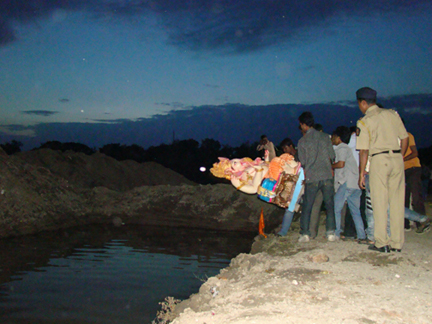
The environmental damage it causes by thousands of idols which made up with harmful materials like plaster of paris and toxic metals, coated with deadly paints containing mercury, cadmium, lead and carbon enters our water bodies. These idols, some of them huge
in size, are immersed in lakes, rivers and the sea. But plaster of Paris won’t get dissolve in water for long so next day you can observe few of them floating on water surface and bank of the river and lake too.
Scientific examination of water bodies tell us after examining the water before and after immersion the scientists found that the concentration of substances like calcium, magnesium, molybdenum and silicon concentrations increased significantly. Also, it was
found that concentrations of heavy metals like arsenic, lead and mercury had increased. Metals like lead and mercury they are dangerous to health and can damage the heart, kidneys, liver, circulatory system and central nervous system. It causes huge damage
to aquatic biodiversity. Large numbers of fishes died after the immersion. As commercial reasons ruled, the natural clay was replaced by Plaster of Paris. These polluting idols are a modern invention and nothing to do with religion. Customarily after worshiping
the divinity in this earth icon, it was returned back to the Earth by immersing it in a nearby water body. This cycle represented the cycle of creation and dissolution in Nature. We requested people to worship Ganesh idols made up of natural clay next year
by explaining the various environmental issues faced due to usage of Plaster of Paris.
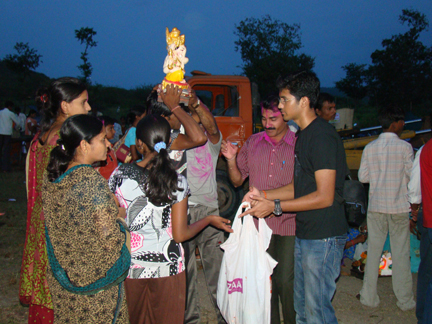
At the same time we appreciated the people who came with the Clay ganesh idols. During the day of Immersion i.e. on 11th October almost 2800 small Ganesh idols and 110 big sized Ganesh idol came for the immersion. During the whole campaign volunteers could
manage to reach almost 8000 people. Dr.Vishal Wadekar, Atul Tikhe, Adwait Keole, Amit Wadatkar took painstaking efforts to reach out as many as people we can. The team of 10 volunteers from ECO Club also contributed during this campaign under the guidance
of Mr.Prakash Laddha and Ar. Vishal Bansod, Director ANT program.
|
Green Defenders
Attempted Rescue of Eurasian Eagle Owl
-Prajakta Hushangabdkar
Early morning 6.15am, on the date of 17th September 2011, Director of ANT program (Ant : Environment Education & Conservation Program) Ar.Vishal Bansod was traveling on the Paratwada road, Amravati. He found a Eurasian Eagle Owl on road side and the Owl was
not able to fly. They took the Owl to a veterinary hospital for treatment. After a primary observation doctors said it was suffering an internal injury. It died during the treatment.
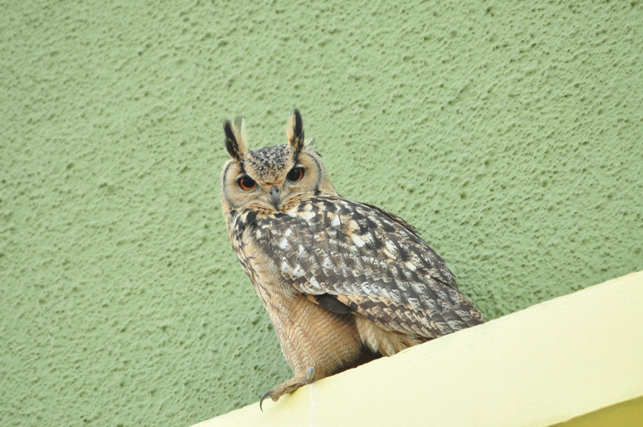
The Eagle Owl is a large and powerful bird. The Eagle Owl has a wingspan of 138–200 cm (55–79 inch) and measures 58–75 cm (23–30 inch) long. Females weigh 1.75-4.5 kg (3.9-10 lbs) and males weigh 1.5-3.2 kg. The great size, ear tufts and orange eyes make this
a distinctive species. It mainly feeds on small mammals Rat, Mice, Hares. Protected in the Indian wildlife protection act 1972 under schedule one.
Like most animals that were in abundance in their natural habitat, man has through irresponsible hunting and careless use of their environment been responsible for placing this species,like so many others onto the endangered list.
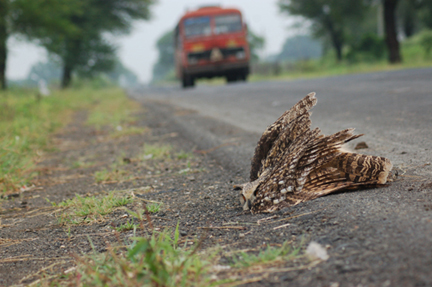
|
Marine Resources
Development vs Conservation
-Susan Sharma
"A division bench of the Gujarat high court refused to direct the Union ministry of environment and forests (MoEF) to allow another environment impact and risk assessment study to develop Positra port. This effectively sealed the fate of the proposed port near
Jamnagar."
Newspaper reports in the first week of September gave the news some importance.
Dr. M.K. Ranjitsinh and Dr. Asad R. Rahamani submitted their joint written report to the Standing Committee wherein the following recommendations have been made :-
"We are of the considered opinion that the country cannot have both the Positra Port and the Gulf of Kutch Marine national Park for the purpose it was established. The choice would, therefore, have to be made between the Park and the Port. Since the nodal Ministry
in this regard is the MoEF, the stand that should be taken is that the interest of the marine national Park should prevail that over the Positra Port and that this proposal of establishing a port at Positra should be rejected."
"While discussing, the proposal on Positra Port, it was observed that the Marine National Park was highly rich in Marine Bio diversity and his highly ecologically fragile area. The Standing Committee also took a note of the recommendation of Swaminathan committee
on Development of new Ports. It has recommended no development of any port within 10 kms. from Ecological fragile area/Protected areas. Committee also considered the report of the inspecting team of the Standing Committee consisting of Dr. M.K. Ranjitsingh
and Dr. Asad Rahmani recommending rejection of the proposal for conservation of marine biodiversity in Marine National Park. Under this background the committee unanimously rejected the proposal to carry out study for EIA for establishment of Port at Positra."
Full details of the judgment can be read at
http://indiankanoon.org/doc/568897/
We had published a report on a visit to Kutch Marine National Park, Jamnagar in our ezine earlier, which can be read at
http://www.indianwildlifeclub.com/ezine/view/details.aspx?aid=436
|
Our choice from facebook this month
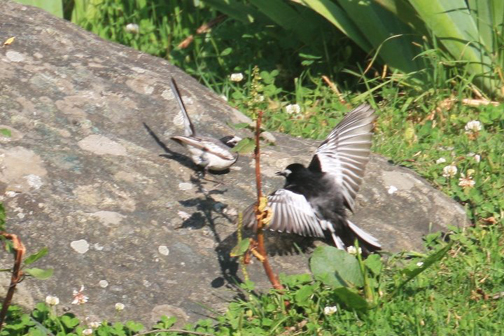
Wagtails
Mir Mnsur posted in the face book group Kashmir Bird life "Wagtail Courtship" (Aru Pahalgam)
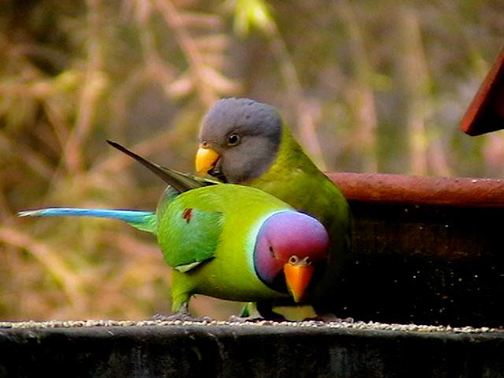
Plum headed parakeets
Surya Prakash posted in the facebook group " Photos of Indian Birds" Urbanbiodiversity Series. 'My Home JNU New Delhi. If you all post pics from your home or nearby that would help knowing other members to do so & conserve their surrounding wildlife.'
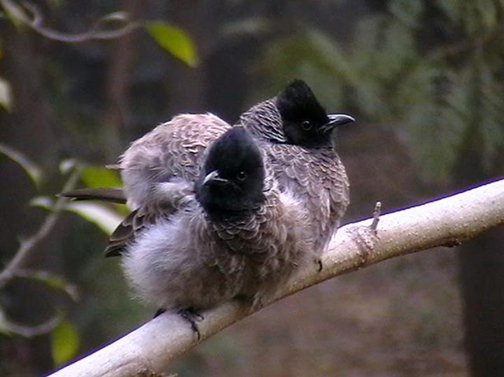
Bulbul pair
Surya Prakash posted in the facebook group " Photos of Indian Birds" Red Vented Bulbul Pair at My Home. I will share more pics to justify my statement in support of urban biodiversity.
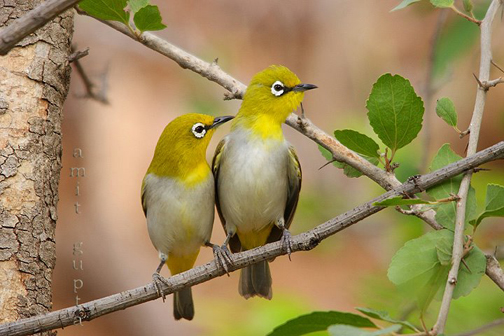
Oriental White eye
Amit Gupta posted in the facebook group " Photos of Indian Birds" " HAND in HAND" Mr. & Mrs Oriental Whie Eye

Grey Jungle Fowl
Sharad Agrawal posted in the facebook group " Photos of Indian Birds"Mr. & Mrs. GREY JUNGLE FOWL sharad agrawal April 2009 kumbahl garh wildlife sanctuary Gallus sonneratii Phasianidae canon eos 40d SIGMA 150-500mm F5-6.3 APO DG OS HSM
|
Web Page
Our Club has a learning page too!
-Dr Susan Sharma
Have you explored our feature-My (personalized learning) Page?
Over the years IndianWildlifeClub.com has developed into a Community of Practice with users sharing experiences through online chats, travel experiences, weblogs and
original articles. We have channeled this information into knowledge, in a Personalized Learning Environment (PLE) on the web portal.
Environmental sustainability will be everyone's concern, if each one of us discovers his or her own personal reason to be concerned about it.
All registered users can now change their profile details, see their uploads (blogs, trip reports) on the portal, see the searches they have made in one place and also scribble notes and save them.
Indianwildlifeclub.com is inspired by and molded by the vision of E.Wenger’s Community of Practice concept.
"Communities of practice are groups of people who share a passion for something that they know how to do, and who interact regularly in order to learn how to do it better. Communities of practice manage their knowledge."
"A community of practice is not just a personal network: it is about something. Its identity is defined not just by a task, as it would be for a team, but by an "area" of
knowledge that needs to be explored and developed. Over time, they accumulate practical knowledge in their domain, which makes a difference to their ability to act
individually and collectively. Domain provides a common focus; community builds relationships that enable collective learning; and practice anchors the learning in what people do." Wenger E, (2001 and 2004).
Team IWC hope that more and more users will start utilizing their "My Page"to aggregate content. We also hope that "My Page" will augment the learning of students who are interested in environment, conservation and ecology.
Involving students in managing their own learning in a variety of contexts, such as building their own personal learning environments (PLEs) according to their goals and
interests, is one way of developing the skills and motivation that will serve as tools for lifelong learning beyond their formal education.
With the urgency and immediacy of many environmental issues, all of us are students in a life -long learning process. Let us help each other by communicating, sharing and acting. We look forward to your feedback on "My Page".

|
Web Page
-Dr Susan Sharma
Informal learning in a "Community of Practice"is gaining more and more acceptance in education, especially under the concept of life-long learning. It is now an agreed fact that envronment learning is a life-long learning process, one that cannot be imparted
by text books alone. Our contexts, experiences, every day practices, aspirations etc. shape the way we learn.
IndianWildlifeClub.com (IWC) is the hub to exchange resources, oportunities and knowledge on nature/wildlife related issues. The IWC platform can be used to network with other nature lovers and plan your initiativies/programs.
The peer to peer world of online learning encourages conversations and reciprocal learning. With the urgency and immediacy of many environmental issues, all of us are students in a life -long learning process. Let us help eah other by communicating, sharing
and acting.
Over the years IndianWildlifeClub.com has developed into a Community of Practice with users sharing experiences through online chats, travel experiences, weblogs and original articles. We have channeled this information into knowledge, in a Personalized Learning
Environment (PLE) on the web portal.
Do explore the features of "My Page"
All registered users can now change their profile details, see their uploads (blogs, trip reports) on the portal, see the searches they have made in one place and also scribble notes and save them.
Team IWC hope that "My Page" will augment the learning of students who are interested in environment, conservation and ecology.
Involving students in managing their own learning in a variety of contexts, such as building their own personal learning environments (PLEs) according to their goals and interests, is one way of developing the skills and motivation that will serve as tools
for lifelong learning beyond their formal education.
We look forward to your feedback on "My Page".
|